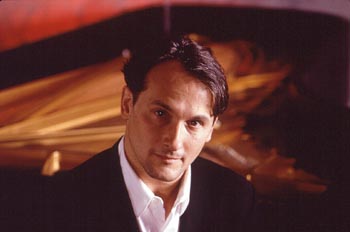![[Metroactive Music]](/gifs/music468.gif)
[ Music Index | Santa Cruz | Metroactive Home | Archives ]
OK Composer
A Radiohead-inspired Christopher O'Riley pulls off a hat trick at Cabrillo Music Festival
By Scott MacClelland
Pianist Christopher O'Riley added star-focus to the Cabrillo Festival's concluding weekend, appearing in all three programs. On Friday, he surveyed his own collection of solo transcriptions from the Radiohead songbook (see The Rock Show), appeared in works by John Adams and Thomas Adès on Saturday, and was featured in Richard Danielpour's concerto Metamorphosis in the Sunday finale at the San Juan Bautista mission.
On Sunday's program of three West Coast premieres, Symphony no. 2 (Island of Innocence) by Kevin Puts won the most immediate acclaim from the sell-out matinee audience. The 22-minute symphony, inspired by the events of Sept. 11, 2001, is tonal and romantic in style, and clearly--even programmatically--expressive. Puts' education at Eastman and Yale reflects those institutions' conservative heritage.
The piece starts as a bucolic postcard on strings, complemented by yearning horns and chattering winds. Gaining momentum, it pauses briefly for a cautionary violin solo, then explodes into violence. The process starts over, this time rising from ashes and aching with anticipation as it builds to another, longer violin solo and, in turn, to a second, broader climax, then subsides into its ultimate resolution. Concertmaster Yumi Hwang played the solos with compelling expression.
Richard Danielpour's Piano Concerto of 1990 is plainly built on classical forms and models. Its animated outer movements--Annunciation and Apotheosis--surround a meditation titled Atonement. Melodic themes carry the piece, presented in original and inverted versions, the stuff of counterpoint. O'Riley played with flair and clarity while conductor Marin Alsop kept a firm hand on her band. Solos on oboe, clarinet, cello and violin enriched the slow movement. The outer movements syncopated confidently and bracingly worked the orchestra without resorting to gigantic shrieks of brass and percussion.
It is that latter indulgence that many composers of new music seem to need to get off their chests. Augusta Read Thomas did it in her Prayer Bells (2001), which opened the program. The work opened in an atmospheric mood, which then gave way to gesturing phrases, and over 12 minutes built up to a texture as dense as it was loud, a kind of sustained dodecaphony that, while not invalid artistically, peaked too soon.
Saturday's concert at Santa Cruz Civic comprised five contrasting works, three by the young Brit, Thomas Adès, and two by the Bay Area's John Adams. The first Adams was a repeat; Eros Piano appeared at Cabrillo in 1991. The piece is a sensual seduction scene by the god of love, a narcissism for piano and orchestra whose title somehow leaves out the expected object of Eros' indulgence, Psyche. Alsop characterized the 15-minute movement as "Ravel meets Bill Evans." O'Riley massaged his part against the languid strings, rising in gentle staccato when they were sliding on glissandos into a dreamy meditation. Surprising among Adams' allusions was a moment in the piano reminiscent of Messiaen.
Adams' Guide to Strange Places of 2001 is a tour de force of orchestral writing--extremely busy, full of minimalist ostinatos (thankfully not sustained indefinitely) and propulsively driven. A quieter passage just before the final assault gave welcome respite, though its chattering flutes and oboes were ultimately shouted down by brass and percussion volleys. It was the latter that both punctuated the 25-minute performance and begged the question: is sheer blaring fortissimo really necessary to "sell" an audience? In any case, this audience was sold enough to return a standing ovation.
The evening's first half went to Adès who, not yet 30, has wowed the British new-music community with his brilliance as both pianist and composer. That brilliance was at its brightest and driest in 1997's Concerto Conciso for piano and 10 instruments, a work of intense intellectual concentration that draws together a plethora of music styles. O'Riley called it a concerto grosso, in which every instrument is a soloist. In its variety and complexity, it combines the zany virtuosity of Charles Ives' Country Band March and Peter Maxwell-Davies' Eight Songs for a Mad King. Of course, anything titled "concise" cannot be expected to make accommodation for expressive niceties, and it didn't.
Preceding the concerto, O'Riley soloed in a work of a different style, Darknesse Visible, a 1992 re grouping of John Dowland's lute song In Darknesse Let Mee Dwell, from 1610. In less than 10 minutes, it follows the Dowland faithfully, but moves the notes into remote octaves, one from the others, and contrasts sharply tolling bells with ghostlike tremolos. At the end, Adès gives us the Dowland straight.
In reflecting on this year's Cabrillo Festival, it is worth applauding the philosophy that allows the music director to follow her instincts without interference from board or staff. Alarmingly, the artistic decisions of a great many music institutions these days are being made by marketing specialists and accountants.
[ Santa Cruz | Metroactive Central | Archives ]
Copyright © Metro Publishing Inc. Maintained by Boulevards New Media.
![]()

The O'Riley Factor: Everything was in its right place for Christopher O'Riley at the Cabrillo Music Festival last weekend.
From the August 13-20, 2003 issue of Metro Santa Cruz.